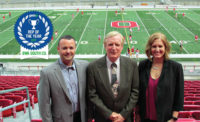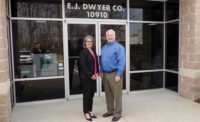Randy Olson, P.E., is thorough.
When the 25-year industry veteran gets his hands on new products, he looks to understand them inside and out. Olson says that has been his mentality since making engineering his career.
“In college, the mechanics of materials and chemistry were of interest to me,” he states.
Olson has continued that quest for knowledge for the last 21 years at Minneapolis-headquartered Dunham Associates and became a partner with the sustainability-focused engineering firm. Olson’s respect for products, design practices and from industry peers has earned him the distinction of pme’s 2017 Plumbing Engineer of the Year.
Product whisperer
Olson has found himself involved in a wide variety of plumbing applications with projects such as the geothermal elements of Great River Energy, the region’s casinos and even vehicle-maintenance applications helping to mold his skills.
“The things I did early in my career contribute to the breadth of materials I’ve worked with in terms of hydronic and plumbing piping systems,” Olson states.
One product Olson has mastered is PEX pipe, especially with major PEX manufacturer Uponor’s factory located only 20 miles south from Dunham Associates’ office.
“PEX is a good material for a lot of reasons,” he states. “It requires fewer joints, has good material properties in terms of flexibility and the ease of installation. It doesn’t seem to have as much a problem with leaching that some other plastics do. When you start talking about drinking water, regardless of whether materials are legal or not, I think we as engineers have a professional duty to look after the welfare of the public.”
Olson’s deep product knowledge helps when working alongside clients on project design. The facility owners and managers trust Olson and his team at Dunham will provide the proper products that will get the job done right.
“If I talk to a client about using something different in terms of materials, sometimes it’s an engineering decision,” Olson says. “We may have a booster system with really high pressure, so we put in stainless steel piping in the domestic water system to handle the high pressure. There isn’t much to talk about there. Other times, we need to talk when there are options where cost, durability, familiarity and comfort level all come into play.
“I don’t think it’s our role as consulting engineers to make an owner do something they’re not comfortable with. It is their building and it is their money and we are advocating for their interests. It’s been pretty rare where I’ve had an open discussion and debate over materials — just a couple of times where somebody on the team wanted to do something that I wasn’t comfortable with.”
Willing to adjust
Recently, Olson’s focus has been on the 511,000-square-foot mixed-use NordHaus facility in downtown Minneapolis. The 19-story apartment complex is coupled with another 22,000 square feet of retail space encompassing an entire city block. NordHaus features hydronic piping throughout the facility, including a domestic booster system. It also has Uponor PEX, copper and stainless steel pipe runs.
“It is really multiple buildings with different materials, HVAC systems, distribution and metering strategies between the low- and the high-rise buildings,” Olson notes.
Jon Fletcher, the development manager with LMC, the owners of NordHaus, appreciates the personal touch Olson and his team bring to the project.
“He’s personable and caring,” he says. “He takes the time to understand what our exact concerns are. He doesn’t provide cookie cutter solutions. He sticks to the issues and works with the team to bring forth a solution that fits the project and is in our budget.”
The original NordHaus plan was for there to be one restaurant kitchen, but as the project developed, Olson and his team had to plan for four units. Fletcher notes subcontractors on the NordHaus project have brought up potential changes to the design and he is impressed with Olson’s willingness to adapt.
“We had to dramatically change our scope,” Fletcher says. “Grease interceptors and additional sanitary products had to be brought in after the fact.
“Randy and his team have been accepting and willing to consider alternatives. He shows a lot of flexibility. The subcontractor suggested an alternative and Randy vetted it out, made his own proposal and we went with it.”
NordHaus has been the first project Fletcher and Olson have worked on together, but Fletcher hopes it isn’t the last.
“We really enjoy working with Randy. He embodies everything you love to see in a consulting engineer.”
Guiding light
Additionally, Olson has been the firm principal on multiple projects within the conversion of the former “Block E” in downtown Minneapolis into the newly branded “Mayo Clinic Square.” One of the more ambitious undertakings is the new facility for a dried meat producer. The project requires the facility meet U.S. Department of Agriculture food processing requirements.
“We’re basically putting in a refrigerated meat locker on an elevated floor of a downtown building,” Olson says. “That is pretty wild.”
Dunham Associates’ work on this facility goes beyond plumbing, as the city is very strict about food odors.
“They do not want odors, so there is exhaust-gas incinerating equipment to burn off the odors from the smokers,” Olson adds. “Our team of engineers has worked closely with a wide array of equipment manufacturers to make it all work.”
Dan Weiss, a senior plumbing designer with Dunham Associates, has been closely involved with the engineering design. The drainage system includes stainless steel Food and Drug Administration-approved trench drains. The facility will be inspected by the USDA, so the cleaning process requires the systems to be cleaned every day with 165° F water.
“We are taking the heat rejection off the refrigeration systems and preheating the domestic water to save energy and use as a buffer,” he says. “You need those because the number-one concern is listeria. We are trying to stick all this 10-gal. stuff into a 5-gal. bucket.”
Weiss has been working at Dunham Associates and with Olson for the past 11 of his 30-year career. He admires and appreciates how Olson can communicate the team’s goal for a project. “He is articulate and to the point,” he says. “When it comes to scheduling and budgeting he has his ducks in a row. You know where you stand at all times.”
Weiss confirms Olson’s deep product knowledge leads to some healthy discussions in the Dunham Associates’ offices, but all for the good of the cause.
“He’ll challenge you on why you’re using a specific product,” he says. “He’ll challenge you on why you used a product in one application, but why you did not use it in another application. He brings a lot of experience and so do I. Sometimes, we don’t see eye-to-eye, but at least we can have an open discussion. It’s not always his way or the highway.”
Green pioneer
When Olson became LEED-accredited by the United States Green Building Council back in 2004, he didn’t waste any time putting that knowledge to work. In 2006, Dunham Associates moved its offices to downtown Minneapolis and Olson was integral in making their facility one of the first LEED-certified projects in the city.
Sustainability continues to be a major factor in Olson’s designs and he continues to maintain his accreditation with LEED.
“My philosophy is green and sustainable design is not a fad and never has been,” he states. “Forever, consulting engineers have endeavored to design efficient systems that aren’t wasteful. I never viewed sustainability as some kind of movement as much as just a continuation of the responsibility we have as engineers.”
Olson has been amazed and inspired by how green design has evolved and improved at such a fast clip.
“What I find fascinating is a lot of the lofty goals and talk that was out there a decade or more are coming to fruition,” he says. “Fifteen years ago the idea of a zero-energy building was a shack in the woods. We’re now seeing zero-energy buildings being built at scale. Minneapolis is one of the most challenging places to do that because of our climate, but why not? They’re doing it in Germany. They’re doing it across our country. They’re doing it in England. Net zero is attainable.”
Doug Wild, an architect with Saint Paul, Minn.-based firm BWBR, has worked on many vehicle maintenance facilities with Olson over their careers. Wild has developed a deep trust in Olson over the years.
“Randy can carry the conversation and bring expertise,” he states. “Any project has issues, but he’s able to get in there and help us deal with them. We’ve often held hands as we jumped into the mouth of a volcano.”
Team leader
Olson made partner at Dunham in 2011 and has been a project manager since 1999. Olson says he does not have to be an omnipresent boss because of the professionals the company has put in place.
“We do a good job of staffing projects with the appropriate people with the experience that matches the project type,” he says. “It’s a group of professionals here so we have good internal training as a company. When it gets down to the basics of design and how you actually do things, we have a great network of experienced people here to turn to for those unusual situations.”
With more than 100 employees, Dunham Associates and Olson have made its internal mentorship program a priority. Olson tries to meet with younger staff for lunch or breakfast at least once a month. Olson makes sure discussions go beyond pipe sizes and drainage.
“It gives us an opportunity to talk about things that aren’t necessarily directly design related,” he says. “It’s more business related such as how you manage people, how you manage relationships, how do you deal with certain things that are some of the softer skills in business. That oftentimes is what we end up talking about.
“It’s one thing to size a pipe. It’s another to give the owner what they’ve asked for, and so there’s communication. It’s the skills of making sure you’re giving the client what they want and what they need. Dealing with situations where you might not agree with what the client wants to do and how do you handle that? It’s a good program.”
Thomas Lind, P.E., and fellow partner at Dunham Associates, works closely with Olson to keep the company at the forefront. Lind, who handles the majority of laboratory projects for the firm, says the rate at which information moves now means Dunham has to be proactive in training the staff.
“We could always do more,” he notes. “The way I learned was I was attached to a senior engineer and learned by doing. The pace is quicker than it used to be, but production is production.”
Olson knows good talent when he sees it and hopes young engineers know there always is a place in the industry if you put forth the effort.
“Regardless of the uncertainty in the industry, there’s always a demand for engineers,” he says. “The college degree creates a bar not many people are willing to jump over. To go through that, develop and become a professional engineer sets you apart and provides you with basic credentials. Then you have to follow that up with hard work.”











